As battles rage on, a photographer returns to a country in ruins, where—somehow—hope remains
The van rolled past the checkpoint into Aleppo, the rebel flag waving us onwards. It was the beginning of Ramadan, in the summer of 2015. Four men wearing balaclavas and strapped with AK-47s stood next to a barbed wire fence barricading the only possibly way into the rebel-held part of the city. They welcomed us to one of Syria’s most devastated cities.
I crossed over with my fixer, Ibrahim, and his friend Nasser, who had returned to Syria to help his family give humanitarian relief. They had donations from Syrians abroad and were delivering food to the orphanage and the internal displacement camps in Atmeh, next to the border with Turkey. Over 60,000 people had fled the violence and were living there.
We reached the ruined roundabout to the Najjaf Industrial District, where we were greeted by a monument featuring two outstretched hands. It was called the “Hands of Cotton”: the industrial zone was once home the biggest clothing and textile factories in the Middle East. It was a strange reminder of what once was. I had been to Syria several times before, and each visit brought new dangers: barrel bombs, kidnappers, snipers. The memories of my previous trips came flooding back as we drove into the city.
The fighting in Aleppo was at a standstill. For four bloody years the war had been raging, leaving over 300,000 dead across the country and Aleppo, once Syria’s thriving commercial center, in ruins. I had seen the war from early on, when the rebels fought with makeshift weapons and the label “Free Syrian Army” actually meant something. Before, there was a sense of unity among many Syrians and hope that an international intervention would put a stop to the fighting. But the rebels became divided and Islamist groups grew in power. I returned to Aleppo to see for myself the people who remained when so many were fleeing to Europe.
The veteran rebel fighter who drove us into the city sighed as we passed the empty shells of the once vibrant factories. “We weren’t expecting all this,” he told me. “We were almost there, winning Aleppo. Then Da’esh”—the Islamic State—“came along. Now we have two enemies—the regime and Da’esh.”
It was late afternoon by the time we reached my friend Nasser’s home. Around us were the black flags of al-Nusra Front, the more “moderate” Islamist group with affiliation to al-Qaeda. We came across checkpoints where the guardsmen eyed me suspiciously. My fixer told them that I was Muslim and on jihad—I have a dark complexion and was born Muslim—and they believed him.
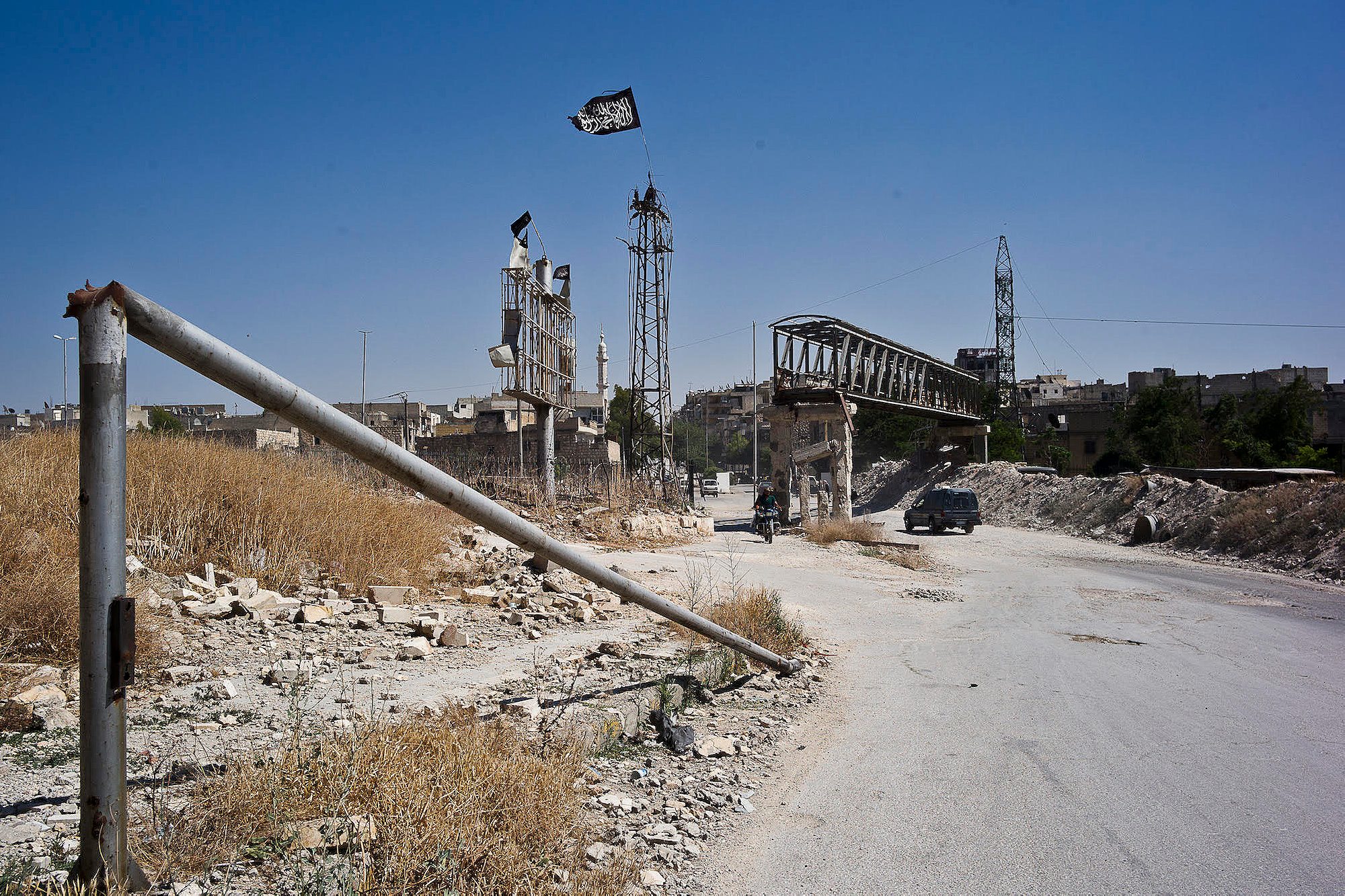
When I started covering Syria, journalists had to cross illegally through the mountains, dodging the Turkish border guards. Sometimes guards were paid off, sometimes they harassed us, and sometimes they turned a blind eye. We jumped over trenches, climbed walls, passed through landmine zones. Once I sat in a gigantic cooking pot and rowed across the river separating Turkey and Syria.
As journalists, we had a fair amount of freedom while traveling in Syria. People wanted to tell you their stories; they believed the media would help bring their stories to the outside world, and that it might just make a difference. But after the murder of journalist James Foley, things changed. Journalists became targets of assassination and kidnapping. These days it’s hard to find people to trust in Syria, even your own fixer. Because if it isn’t Assad offering money for Western journalists, it is ISIS, or some smugglers wanting a payoff.
After the killing of Peter Kassig, a humanitarian aid worker, the U.S. Department of Defense made it a priority to push the Turkish authorities to close down all access to Syria for westerners to enter legally, whether for humanitarian or journalistic reasons.
Keeping in contact is difficult in Syria; using a satellite phone could get you killed by an Assad warplane. Even using Syriatel, the local network, could be tracked and monitored. Instead, we came to rely on Internet cafés with VPNs to hide our whereabouts. As the dangers to foreign reporters grew, we relied on local media activists for information about what was happening on the ground. These people are usually unpaid, and risk imprisonment and death for their reporting.
The sound of the azan marked the end of fasting and the beginning of the barrel bombs. Throughout Ramadan the crude bombs—oil barrels packed with explosives and metal—had been dropped from helicopters at the start and end of each day’s fasting, intending to strike while people gathered. One night, a barrel bomb hit while people were gathered at the Ansari mosque. Fifteen people were killed and several wounded.
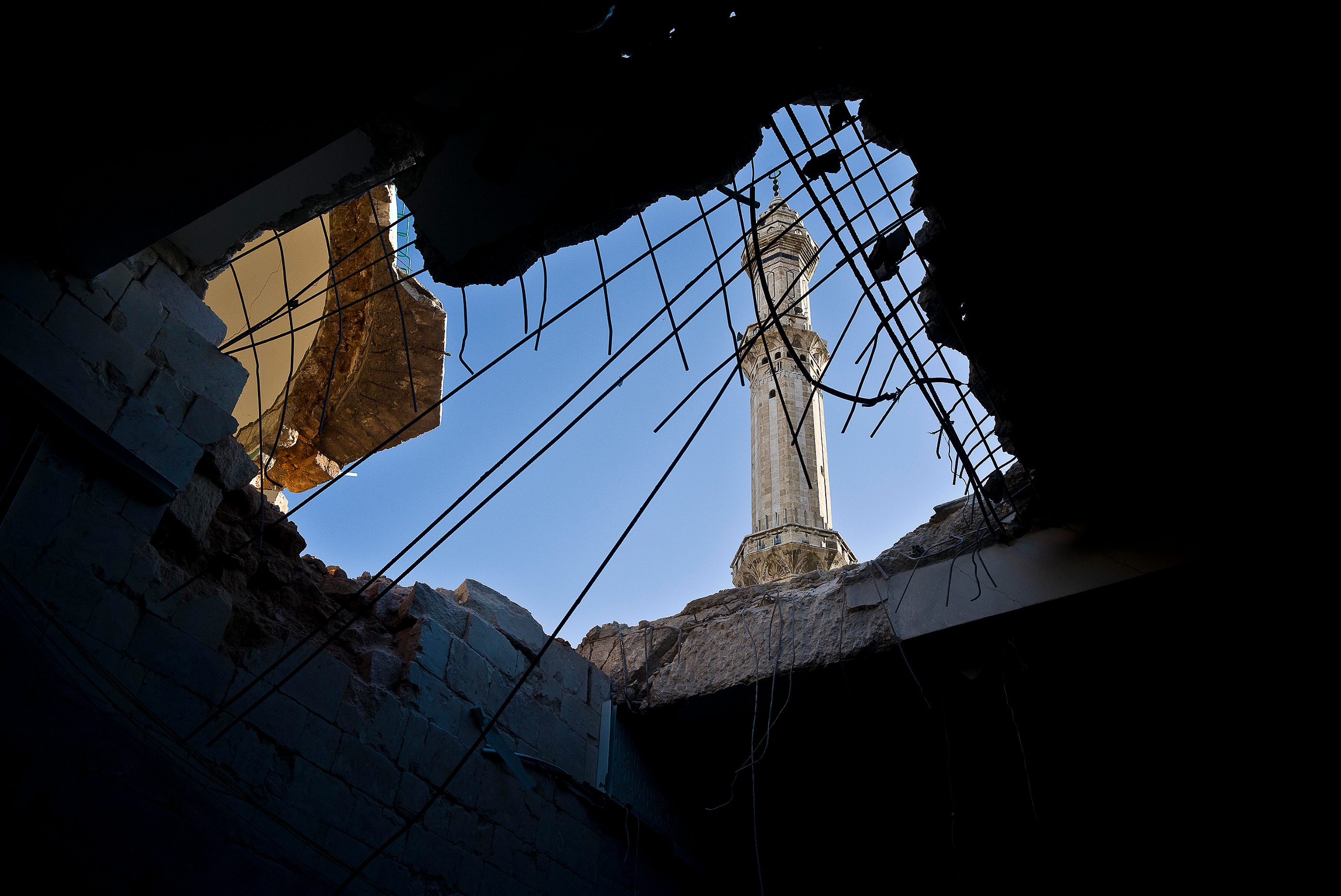
We visited the Al Mashad market bazaar. The falafel man didn’t want money for food—it was an honor for him to serve a visitor to his country, especially during Ramadan. After dinner, Ibrahim and I sat outside by the coffee shop and ordered two espressos. At night, life returns to the city. Men gather in front of shops, chatting and watching a local television show called “Banned in Syria,” a comedy set in present day rebel-held Syria. Most of the people were not actors, but locals who lived in the area. It offered laughter and brief escapism for those living in a war zone.
We spent the next few days near the frontlines. Tension was building. Al-Nusra and the FSA were launching a campaign called “Jaysh al Islam” (“Army of Islam”) aimed at taking back Aleppo. The rebels captured part of the Zahra neighborhood. They also advanced on the citadel and the Science Facility, which was now used as a facility to make weapons. The government responded by using weapons called fil (“elephant”) missiles, which landed almost every minute throughout the night.
One day we met the First Brigade’s media activist at his home. First Brigade was one of the largest and most powerful Free Syrian Army brigades in Aleppo. On the floor was body armor, torn to shreds. The media activist who had once worn it survived the bullet to his torso, but not the one that hit him in the face. At least six Syrian citizen journalists had been killed over the last few days, either on the front or from barrel bombs. The body armor would be refitted and reused again by another media activist or fighter.
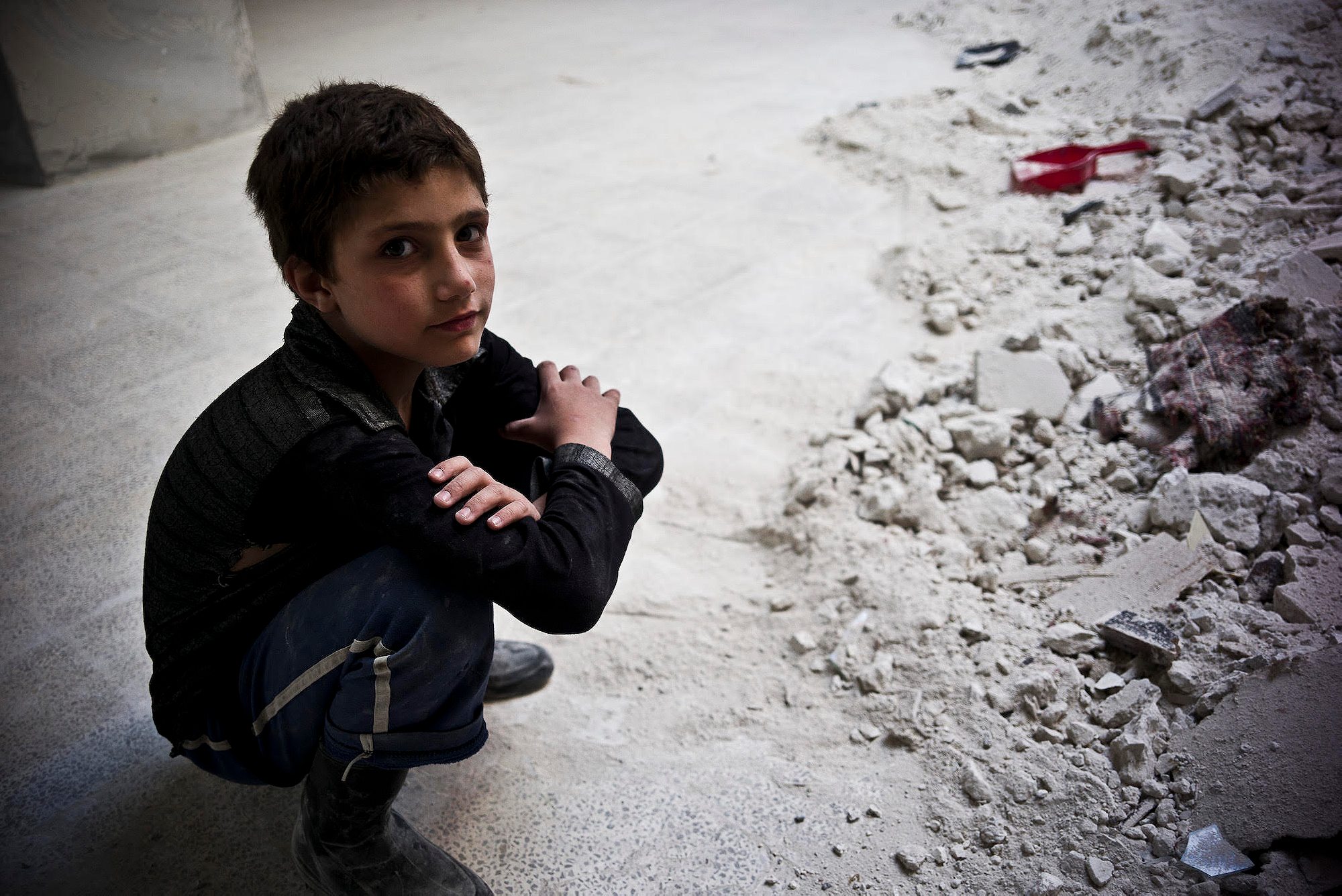
It was too dangerous to report from Zahra, so another FSA brigade, called Nour De Zenky, offered to take us to the Science Facility.
We woke early and went to Nour De Zenky’s base, where we piled into the back of a pickup truck and drove to a forward base. We were accompanied by some media activists and an energetic 12-year-old named Ahmed. He said he loved being with his family on the frontlines. The fighters nicknamed him “little hero” and he lapped it up, showing off his skinny muscles and flashing a cheeky grin. He claimed to be my bodyguard and said he would protect me in the case of trouble. I laughed nervously.
The Science Facility was deadly quiet. It had been only a day or two since the resistance groups had captured it. The regime had pulled back to defend Zahra and the university. They had been making elephant missiles here, and now the rebels could use the material to do the same.
It was hard to believe that the facility had been occupied just days before. It had been reduced to rubble. There was graffiti on the walls, UNHCR food packages, debris.
A rebel had found some nunchucks and was swinging them around. I grew up with a father who taught kung fu and so I showed the rebel how to swing them properly. He handed them to me as a gift. As we looked through some of the files strewn about, we heard an elephant missile’s trumpet call.
There was a blast close by. I felt the pressure of air shifting, like a wave crashing in on me. The sound was deafening. I dropped to the ground without thinking.
Elephant missiles have zero accuracy
A nearby building had been hit. Dust filled the air and pieces of concrete fell by our sides. We ran looking for cover in a maintenance building. There, we waited for almost half an hour while missiles fell every few minutes. Ahmad ducked under a metal workshop table, fearing that the roof might collapse. Outside was the sound of gunfire and rebel rockets firing back at regime positions.
Elephant missiles have zero accuracy and soar malevolently into the air without any guidance. Soon everything became silent again, and we made a run back to the truck, hoping it would still be there.
We heard a radio call warning that a Syrian jet was in the air above. All vehicles would be targeted. Our driver sped flying over the potholes trying to avoid the jet’s sights. Ahmad, the brave boy, finally showed worry on his face. We were sitting ducks.
We arrived at another Nour De Zenky base and I was extremely relieved get out from under the open sky. We were covered in dust; I could feel it through my hair. Ahmad was even more glad to be at the base. His uncle was there, and he embraced the boy tightly. At first, the base filled with laughter and relief, but it was quickly followed by more worry.
Ibrahim and I went to Nasser’s home in Aleppo. Nasser had some great news: His brother, Abdul, had managed to return home. Abdul had been conscripted into the Syrian Army when the civil war broke out. He tried escaping once, but was caught and badly beaten, and he still bore scars where an extendable baton was struck against his flesh. The Army executed some of the others with him for desertion. He had been lucky.
Jaysh al Fatah (“The Army of Conquest”), a large rebel operation, had conquered Idlib, a large city west of Aleppo, and were swiftly moving south towards Latakia and Hama, where Abdul happened to be working in the operational command based in a hospital in Jisr Shughour, a nearby town. Seeing another opportunity to flee, Abdul escaped and began negotiations with the rebels for his surrender. Al-Nusra Front accepted him, and he was able to contact Nasser and his family who lived on the rebel side of Syria. After a month of detention, Nusra decided that Abdul could return to his family.
There was a celebration to mark Abdul’s return. His brothers Mahmoud and his uncle Mohammad threw him a party. The drums played, and they sang and danced. The sun was creeping in before we finally fell asleep to the sounds of helicopters and barrel bombs. We slept soundly despite the chaos that surrounded us.

At midday we left for Atmeh, a refugee camp by the Turkish border. We crammed uncomfortably into a hatchback for the three-hour drive. Two fellow passengers, Mahmoud and Mohammed, ran an NGO called the Syrian Smile Foundation. They had money to distribute food to the needy during Ramadan.
Mahmoud, a small, highly motivated man with large glasses, wanted to drag us along mainly because I was a photographer and he hoped I could provide them photos they could use to garner more support for their work in Syria. The hatchback had issues, and we had to stop constantly to replace the water in the radiator. We passed vegetable and fruit crops, and I could see life was slowly returning to the farms and fields.
Atmeh camp was built into the hills close to Turkish border. It was dry and dusty through the summer and often flooded in the winter. The al-Nusra Front held the checkpoints along the road to Atmeh, but they were relatively relaxed because we were working with an NGO and helping with food distribution. Still, at each checkpoint they asked for more of my background, and I grew increasingly nervous until we arrived at Atmeh safely.
We were given a space to sleep and set up for food distribution. We would be cooking for almost 1,000 orphans each day for 12 days. Gigantic cooking pots were erected and I started my day by peeling potatoes.
There were two activists from Homs who came to help us, Tamer and Wiam. Tamer was a young and well-connected social activist who had been soliciting donations from Syrians already living abroad and generally trying to help in any way he could. I partially didn’t trust him because of his positivity. It was rare, after years of war, for people to stay positive. Wiam, on the other hand, bore a streak of cynicism. She was Kurdish, from Homs, and was there during the early days of the war. She documented everything with her camera. She started with the early protests, and then when everything went to shit she found herself filming the regime firing mortars into the crowds.
She was often told to wear a black abaya. She refused
When Homs fell, she was invited to speak in France and elsewhere about what was happening. Everything seemed to fall on deaf ears. When so many were fleeing to Europe, she wanted to die in her homeland. Though France had already given her refugee status, she chose to return. Her frail parents were still trapped in Homs. Often, in her down time, Wiam was on her phone looking at photos of her father. It was the only thing she had left. Her dream was to build a school in Atmeh, to help teach the children before they became illiterate. She had some donations from friends overseas. It wasn’t much, but it was something. She longed to return home to Homs.
Wiam disliked the Islamists because they were obliterating any sense of freedom in her country. Women in Syria had been able to choose whether to wear a headscarf or not. They could choose to work or study. Now Wiam was often told to wear a black abaya. She refused.
The orphanage was huge, home to more than 800 children. Most of the orphans’ fathers had lost their lives fighting with the Free Syrian Army. One of the first trips I made to Syria was to find an Australian kickboxer named Roger Abbas, who had reportedly been killed in Aleppo by a regime sniper. As I followed his trail, I learned that he had been working in the camps of Baba Salam before joining the fight in Aleppo with the FSA. When you see the living conditions of the children here, the hundreds of refugees fleeing, the bombings, it seemed to me that it would be easy to pick up a weapon and fight.
We went shopping at the markets to buy cheap vegetables and grains. Tamer lent me his motorbike, and I rode around the camp taking pictures of the children. There was very little schooling or facilities for the kids in the camps. Life was slow in this place, and most of the people didn’t have the money to flee. Most were waiting for their home villages to be liberated or for the war to come to an end.
We planned to travel to Kafranbel, a town in Idlib that is home to a Syrian activist group called Radio Fresh. Each Friday the group’s members make banners and posters, and protest. On Fridays, the activists photograph themselves holding the banners and post it on Twitter or Facebook. It is one of the longest running protest groups in Syria.
Wiam joined us, and we hired a driver and a pickup and headed down the highway. On the way, we passed through the town of Maaret Al-Numan and saw that it had been laid to ruin. We made it to Kafranbel on a Friday. Helicopters were in the air, so the protest was on hold. We made it to the radio station and met the organizer of the protest. He showed us the posters and the banners, which ridiculed the regime, ISIS, and American policy. One featured Assad feeding Abu Bakr al-Baghdadi, drawn as a baby drinking from a milk bottle filled with the blood of Syrian civilians.
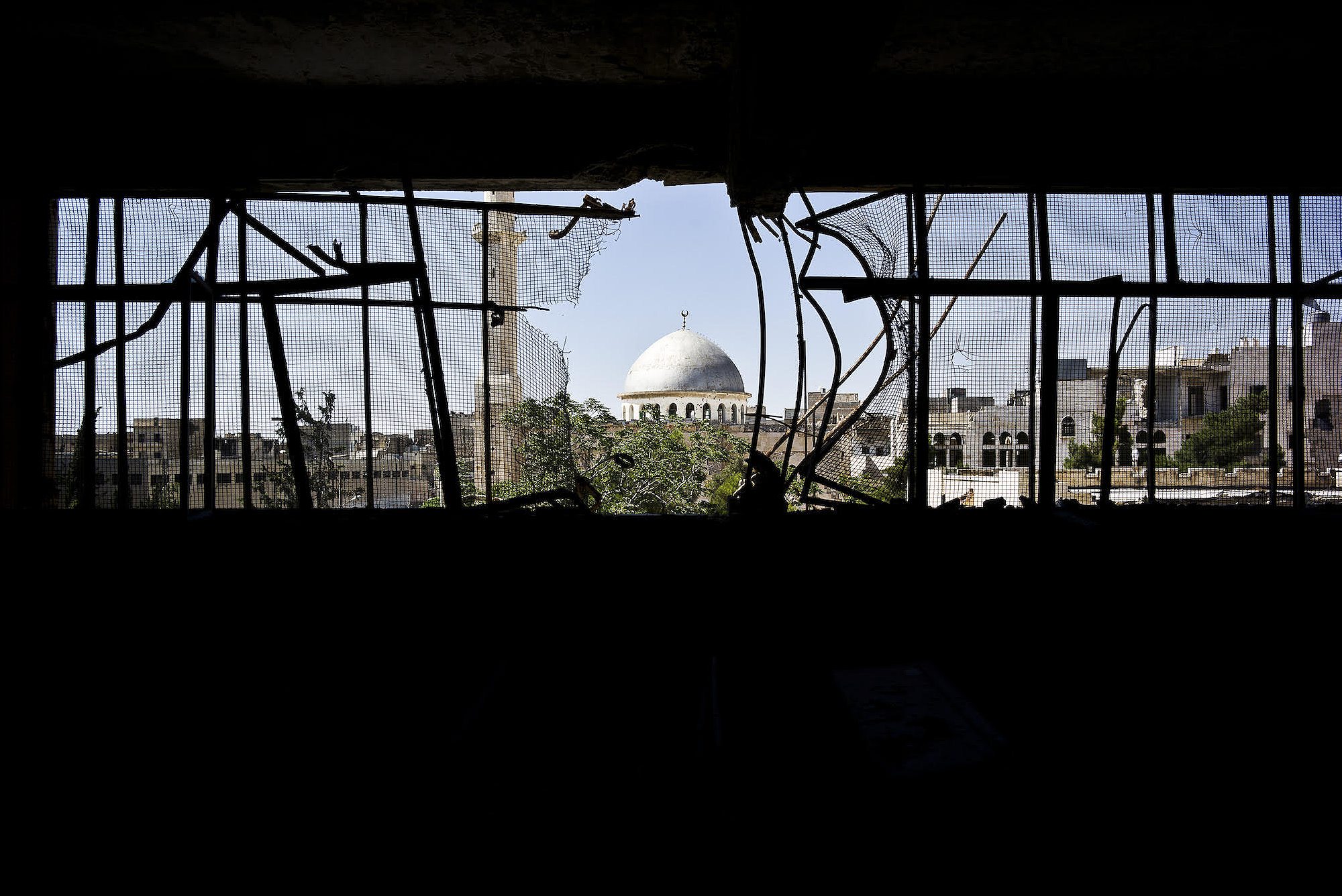
On the way back to Idlib, I fell asleep in the back of the pickup and woke to the sight of regime flags. The pickup stopped at the front of a government office. It was an empty husk of a building. A large, torn poster of Assad flapped in the wind. The battle had only lasted a week, and the government was driven out. Jaysh al Fatah now controlled the city.
We took selfies by the government building. Idlib was another step toward defeating Assad, but there still seemed to be a giant leap to victory. Jaysh al Fatah was advancing toward Latakia and Hama. There was progress in the south of Syria as well.
Civilians were returning to Idlib. A coffee house was being built and the marketplace was being stocked. A Corolla taxi rolled into town with bedding and luggage attached to the roof. With so many leaving Syria, there were still a few returning to their lives at home. The battle in the city was rather quick, and the visible damage wasn’t as bad as Aleppo.
“We will stay,” a man who had returned to the city with his wife and children said to me as they were unpacking. “There might be nothing left. We might be bombed. We might be gassed by chemicals, but I would rather be home than to be miserable without my homeland. We live and die in Syria.”
The family had been living in the Atmeh camp, and they thought about making the journey to Europe, but they were penniless. Upon returning to their hometown, the courts helped find them a house. Electricity services and water distribution was being provided by technicians working for the al-Nusra Front. People would be given food handouts and jobs to assist in the clean up crew.
We returned to Atmeh. We were photographing the destruction along the way when a militant stopped us. He was angry and told us to follow him. Apparently we were close to one of their bases. I started to worry that he might be detaining us.
Ibrahim and Tamer spoke to the al-Nusra leaders. A boy who looked to be no older than 11 was dressed in military garb and holding an AK-47. Fighters surrounded the truck. They were more interested in Wiam than in me. She was wearing a dark red scarf around her hair, but her neck and face were showing.
They reviewed our photos and let us go, reminding Wiam that she should dress more appropriately. Wiam didn’t argue, but inside she was fuming. It was a long and mostly silent ride back to the camp.
I wanted to get back to work in Aleppo. Atmeh camp was interesting, but Aleppo was at the center of the conflict now, especially since the battling was happening in Zahra.
Mahmoud’s car had some problems, but we decided to drive to Aleppo in the middle of the night anyway. After 30 minutes, the fan belt broke, and we came to a slow halt. Using rope, we tied his car to the pickup that was traveling with us and kept going. It was a treacherously slow drive, and I was sure most of the guys were angry with me since I was the one who thought we should leave in the evening. Our vehicle kept detaching from the other pickup, and it was early morning by the time we arrived in Aleppo.
The fighting in Zahra had become intense. Ibrahim’s family home was there. His father lived on the regime side and refused to move or flee. We wondered what remained of the neighborhood with all the missiles being used.
I went to visit my friends at the civil defense unit, known as the White Helmets. I first came here back when this war was still just a protest, and they have been my closest friends in Syria since. The civil defense are the men and women who go to assist with the rescue recovery of wounded civilians after a barrel bomb has fallen.
One particular trip with the White Helmets still haunts me. We were responding to a bombing in which an airstrike had struck a van carrying civilians. A woman was decapitated by the blast and held her lifeless infant son in her lap. Since then I haven’t been able to get the image out of my mind. I’ve cried for days thinking about it.
Assad punishes us for wanting to be free
When I saw my friends in the White Helmets we laughed and hugged. They joked that I was their lucky charm—whenever I was around, they said, there were no barrel bombs.
“Never leave! Get married here!” Hassan Alkhalaf, a senior member, joked.
Hassan had been with the group for almost three years and had seen more death than you can imagine. “Assad punishes us for wanting to be free,” he said. “Our death is not a worry. We cannot feel anything when we are dead. When our family, our children, our friends die—that is the suffering.”
Hassan took out his smart phone and showed me photos of the slain Canadian photojournalist, Ali Mustafa. Ali Mustafa was a young, very talented photojournalist who covered the Arab Spring and then the war in Syria. He spent a week with the White Helmets covering the barrel bomb attacks. One day a regime helicopter dropped a barrel bomb, and then another when the White Helmets arrived to rescue the wounded—a tactic known as “double tap.” Over six members of the unit were killed in the attack, as was Ali Mustafa after he received shrapnel to his head. His body was then transported to Turkey and brought to the Canadian Embassy.
We spent mornings monitoring the helicopters. We heard radio reports of the neighborhoods they flew over. Each helicopter could carry two or three barrel bombs, depending on the weight. The larger ones were about 500 kilos of packed explosives and shrapnel. Between 6 a.m. am to 10 a.m. they would do two or three runs. The White Helmets sat ready and waiting for the reports to come in. Several bombs dropped, but there were no casualties; some didn’t explode.
Some Aleppo civilians had set up group messaging programs to notify each other of the helicopters whenever they were in the area. People held radios on their sides to listen in on helicopters as well. They had the means to warn each other and within a moment’s notice could close up the market and find necessary shelter. Still people died, but at least now there was more of an organized system in place that could help keep people slightly more safe.
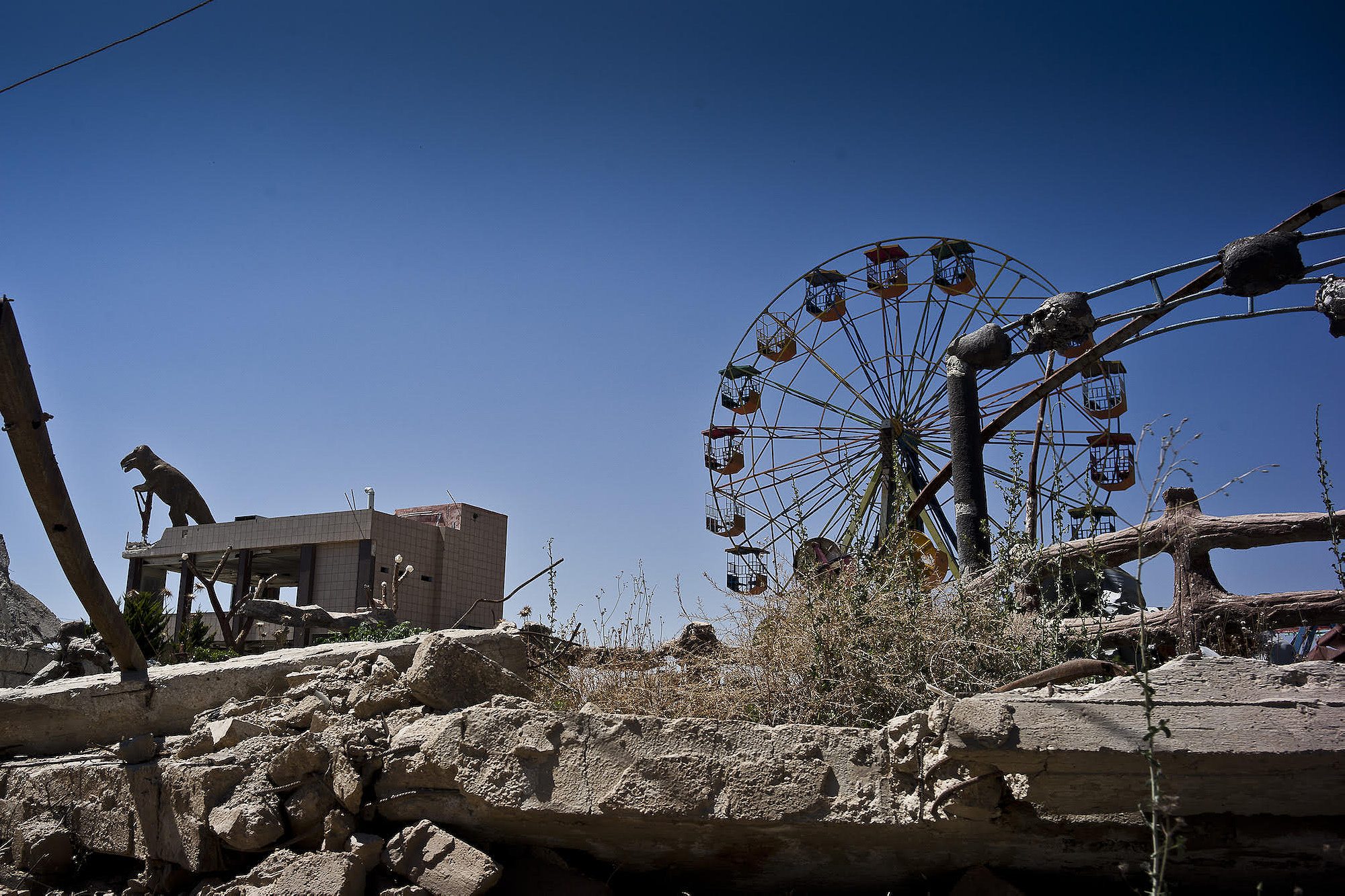
It was late in the afternoon in Shaar district when a barrel bomb fell on a row of busy shops, one of them a makeshift petrol station. It caught fire and exploded. Over 20 people were killed and a dozen wounded. Their flesh was burned black.
Najib, the leader of the White Helmets, stacked the dead in the pickup truck—a dozen bodies, on top of each other. The hospital vans picked up and crowded the wounded and took them to the makeshift underground hospital for treatment.
Most of the medical equipment at the hospital was from the 1970s. It had been targeted several times before and had to constantly change its location. Many of the doctors had fled Syria; the few who stayed could now be counted on two hands. They worked tirelessly with the wounded.
“The regime punishes us. It makes us want to flee Syria,” a surgeon told me as he prepped for another patient. “If we leave, we never want to come back. There is nothing left for us.”
I looked at the faces of the wounded, some were children, their parents doting on them even though they were wounded themselves.
Later, we went to the blood bank. It had narrowly avoided the wrath of a regime barrel bomb, and a large hole now took the place of a window. The manager was happy to see us, so happy that he set us up to give blood while giving an interview. “If I had a message for the West but also the whole world: If you have the power to stop the war in Syria, do it,” he said. “If you can’t, please do not fan the flames of war.”
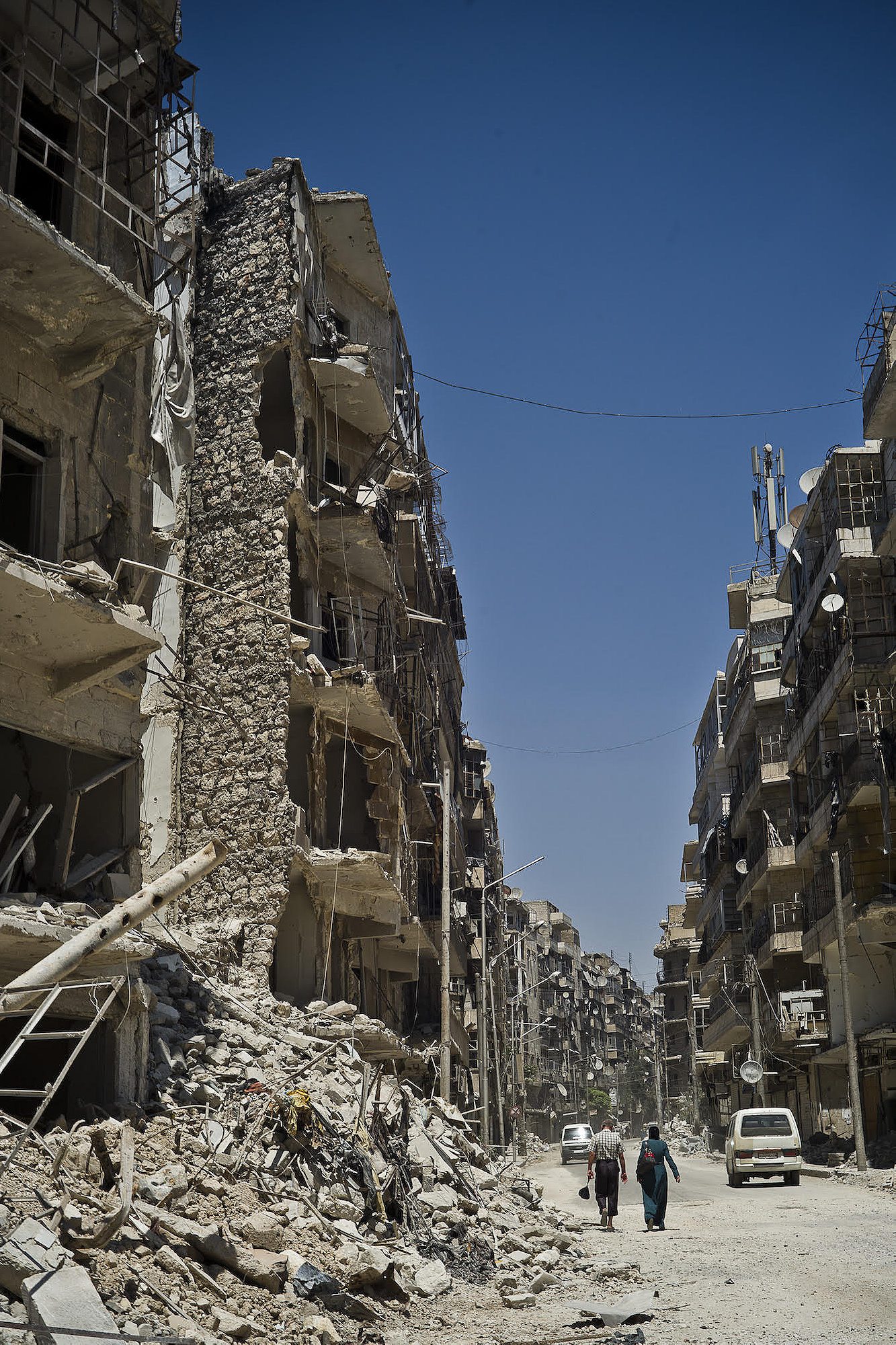
The next day we visited a school. It was hidden away in the marketplace. The classes were filled and the teachers running it were women. Zeina, the head principal, allowed us to walk around and see the classes, each filled with children.
“At first, we were too afraid to send our children to the schools because of the barrel bombs,” she said. “But now we send them. Bashar al-Assad, he wants the next generation to be ignorant, illiterate. He bombs us into fear, he makes us flee, we lose our heritage, we lose our culture, we lose our religion. The fear we have is ingrained into our children.”
Zeina was a proud mother of two. Her husband helped her make sure that she and the other women in Aleppo would be running schools and education in the city. The Free Syrian Army had issued educational books for children, mathematics, science, Arabic, and religious studies.
The people who do leave Syria do so because there is nothing left of their life and they can no longer live under the dangerous conditions that have claimed so many of their family and friends already. People want to live and feel safe with their families, and that can no longer happen in Syria. Those who stay, like Zeina, endure, and hope that some day soon the carnage will abate and normal life, or some semblance of it, will resume.